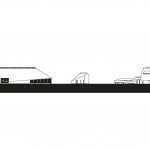13.2.2015
Naturum Tåkern
A number of visitor centers have been designed and built for Sweden’s most interesting nature reserves, and all are unique. Designing a building that helps guide visitors is a gratifying task for an architect.
While the conditions are more open than for most building projects, the goal for these buildings is to heighten the visitors’ experience of nature, and that places great demands on both their design and their execution. The Lake Tåkern Bird Sanctuary, with its enormous fields of wetland reeds, teaming underwater life, broad beach meadows, and open woods along the water’s edge, is a kind of paradise—and not just for the birds, but also for those who come to enjoy the wealth that nature has to offer.
The Tåkern Visitor Center looks at first like a solid block cut from the reeds. But the thatched building is actually folded to form an outdoor room open to the birds and the sky above. The folds generate organic forms that are at home in their natural surroundings. And the center and its observation tower are intended to be little more than hiding places at the edge of the forest. The dimensions, forms, and materials humbly defer to the Tåkern landscape.
The opportunity of planning a visitor center at Lake Tåkern began with an invited competition in 2007. Wingårdh Architects won with a scheme that was in all significant aspects the same as the building eventually inaugurated in 2012. The site at the forest’s edge allows the building and its tower to be at home in the woods and among the reeds as well. The meandering path through the woods to the tower takes care of its visitors, just as the building’s courtyard shelters them from the wind. The path is more than just a suitable way to get a view of the lake from above. Returning to the woods after having glimpsed the water, all of us, regardless of our mobility, become aware of the life that is also thriving up in the trees.
The architecture of the visitor center has been modeled into form. The tower might recall a shorebird on long legs or a birdwatcher hunkering down with a cap pulled down over his ears. The look of the main building is more a consequence of the interior’s minimal need for openings. Exhibits prefer enclosed spaces, but also daylight from above. In addition to skylights at the ridge, the building needed light and views from three different points. The first is the entrance, where contact with the courtyard outside makes the way into the exhibition short and pleasant. The second opening is a view out along the entrance axis that leads visitors into the exhibition space. The third is in the far corner of the space, where a long and low window offers a panoramic view.
The ridge is the most vulnerable part of a thatched roof. Here the thatch has been replaced by glass, which is not only a technically safe way to finish off the thatch but bathes the interior in light from the sky. Looking up, we see the wooden birds of the exhibition with the sky behind them as in nature.
In this way, Lake Tåkern’s reeds give the building not just its cladding but much of its form. Thatch is a practical material that can easily be renewed if it should be damaged. When laid over a solid sheathing, air can’t get under it to feed a fire, so the material will do no worse than smolder. The roof and walls are clad with more than 25 centimeters of thatch over 20 centimeters of insulation, and together they make for a cozy refuge. The steep pitch of the roofs gives the thatching an estimated lifespan of more then fifty years.
A small portion of the lake’s reeds are cut every year in the early spring, and the 2011 harvest from Väversunda farm was used to clad the building—some 36 million reeds in all. It is not the only local material used in the building: there’s also Borghamn limestone from the across the lake in Omberg, and pine from the surrounding forests of Östergötland County. The design establishes a dialogue with history by updating the local tradition of thatched roofs with a decidedly modern form. Another such dialogue is the contrast between the building’s rational form and its classical section. It’s an architecture that makes room for time.


























